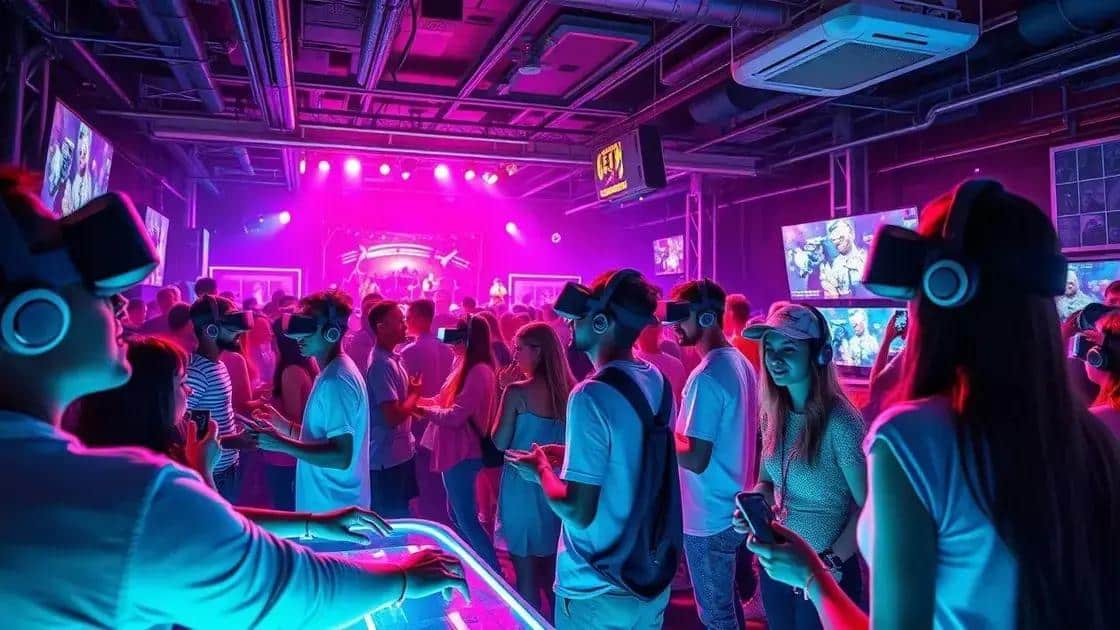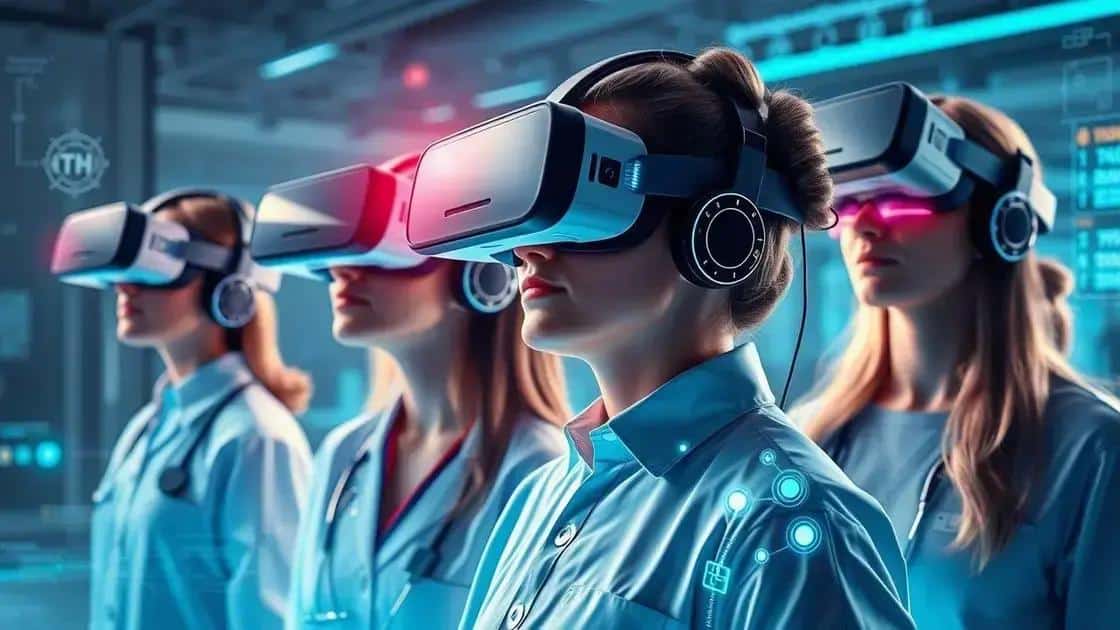Insights on vr/ar entertainment industry: what to expect

The VR/AR entertainment industry is rapidly evolving, focusing on increased immersion, wider applications in various fields, and personalized user experiences, significantly enhancing audience engagement.
Insights on the vr/ar entertainment industry are crucial for understanding how these technologies are reshaping our experiences. Are you curious about what’s on the horizon? Let’s explore the latest trends and innovations together.
The evolution of vr/ar technologies
The evolution of VR/AR technologies has significantly changed the entertainment landscape. Over the years, these technologies have progressed from simple experiences to complex simulations that engage users like never before. Understanding this evolution helps us appreciate current trends and innovations.
Early Beginnings
Virtual reality started in the 1960s with basic experiments. However, it wasn’t until the late 20th century that VR gained popularity. The development of devices like the Virtuality arcade system brought VR to the masses, offering immersive gaming experiences.
Technological Advances
As time went on, improvements in hardware and software led to richer experiences. Key advancements include:
- The introduction of motion tracking technology, which allows users to interact with virtual environments seamlessly.
- High-definition graphics that enhance realism and immersion.
- The rise of affordable headsets, making VR accessible to a larger audience.
These technological leaps have paved the way for more engaging content across various entertainment mediums. The integration of augmented reality is also noteworthy, blending digital elements with the real world. Games like Pokémon GO exemplify how AR can transform traditional gameplay, creating shared, interactive experiences.
Looking further into the future, we can expect continuous improvements driven by innovation. The combination of AI with VR and AR will lead to even more advanced applications, offering personalized entertainment options. Users will soon find themselves in experiences tailored to their preferences, making the future of VR/AR incredibly exciting.
Current trends in vr/ar entertainment

Current trends in VR/AR entertainment show an exciting shift in how we engage with stories and gameplay. These technologies are becoming more sophisticated, leading to richer experiences that keep users coming back for more. Let’s delve into what’s happening right now in the VR/AR space.
Increased Immersion
One major trend is the push for greater immersion. Developers are focusing on creating experiences that transport users into fully-realized worlds. This is achieved through:
- Advanced graphics that resemble real life.
- Spatial audio technologies that create a realistic sound environment.
- Haptic feedback systems that provide physical sensations during gameplay.
Such advancements make users feel as though they are truly part of the action, significantly enhancing engagement. As immersive experiences grow, so does the variety of content available.
Social Experiences in Virtual Spaces
Another exciting trend is the rise of social VR. Many platforms are now allowing users to connect with friends and interact in virtual worlds. These can include:
- Virtual hangouts where avatars can meet.
- Collaborative games that promote teamwork.
- Live concerts and events hosted in VR environments.
Social interactions in VR provide a unique way to connect, especially during times when in-person gatherings are limited. This shift emphasizes the importance of community in entertainment.
Furthermore, the integration of artificial intelligence is reshaping VR/AR too. AI can personalize user experiences based on preferences, dramatically changing how content is created and delivered. Imagine a game that adapts its storyline based on your decisions, providing a unique narrative each time you play!
As these trends evolve, we will continue to see new innovations that challenge traditional forms of entertainment. Familiarity with these trends allows both consumers and creators to stay ahead in the vibrant landscape of VR/AR entertainment.
The impact of vr/ar on audience engagement
The impact of VR/AR on audience engagement is profound, as these technologies create immersive experiences that captivate users. With VR and AR, audiences are no longer passive viewers; they become active participants in their entertainment.
Enhanced Interaction
One of the primary benefits of VR and AR is the ability to enhance interaction. Users can manipulate and explore virtual environments. This leads to:
- A deeper emotional connection with the content.
- Improved retention of information through interactive learning.
- Increased excitement and enjoyment during gameplay.
By engaging users in this hands-on way, developers can create lasting impressions that traditional media cannot achieve. Imagine being on a spaceship, exploring distant galaxies, and interacting with alien species—this is the magic of VR.
Personalized Experiences
Another significant aspect is personalization. VR and AR enable content creators to tailor experiences based on individual preferences. This results in:
- Customized storylines that evolve based on user choices.
- Regularly updated content that reflects current trends.
- Experiences designed specifically for different demographics.
Such personalization makes every interaction unique, ensuring audiences feel more connected and valued. It transforms passive consumption into a customized journey that resonates on a personal level.
This shift in engagement strategies not only benefits the audience but also creators and brands. The richer the user experience, the more likely they are to share their experiences with others. Social media platforms buzz with VR content, extending the reach of brands and attracting new audiences.
As VR and AR technologies continue advancing, we can expect even greater engagement strategies to emerge, bringing audiences closer to the stories they love.
Future predictions for the vr/ar industry

Future predictions for the VR/AR industry reveal a landscape filled with possibilities. As technology advances, we can expect remarkable changes that will redefine how we experience entertainment. Experts are suggesting several trends that will shape the future of this industry.
Wider Adoption in Various Fields
One key prediction is the wider adoption of VR and AR across different sectors. Not just for gaming, these technologies will find applications in:
- Healthcare, where simulations can improve medical training.
- Education, enabling immersive learning experiences for students.
- Real estate, allowing virtual property tours to potential buyers.
As more industries recognize the benefits of VR/AR, the potential for innovative applications expands. This opens doors for creative solutions that enhance user experiences.
Advancements in Technology
Technology will continue to advance, improving the quality and accessibility of VR/AR systems. We may see:
- Improved hardware that is lighter and more comfortable to wear.
- Better graphics and audio for a heightened sense of realism.
- Increased integration with AI, creating smarter and more adaptive experiences.
These developments will not only enhance the user experience but will also attract a broader audience to enjoy VR/AR content.
Social interactions in virtual environments will also evolve significantly. More people will find themselves attending virtual events or hangouts, fulfilling social needs without being physically present. This could lead to a more interconnected global community where friends and family share experiences, regardless of distance.
The future may also see a boom in user-generated content, as platforms become more accessible. Users will have the tools to create their own virtual worlds, enhancing creativity and collaboration. As individuals share their creations, we can expect a vibrant ecosystem of diverse content that enriches the VR/AR landscape.
FAQ – Frequently Asked Questions about the VR/AR Industry
What are the main benefits of using VR and AR in entertainment?
VR and AR create immersive experiences that engage users, allowing them to interact with content in ways that traditional media cannot.
How is VR being used in education?
VR enhances learning by providing interactive simulations, allowing students to explore and experience subjects in a way that promotes better understanding.
What advancements can we expect in VR and AR technology?
Future advancements include improved graphics, lighter headsets, and better integration with AI to create smarter, more personalized experiences.
How can businesses utilize VR and AR for marketing?
Businesses can use VR and AR to create unique experiences, such as virtual product demonstrations and interactive advertisements, to attract and engage customers.





